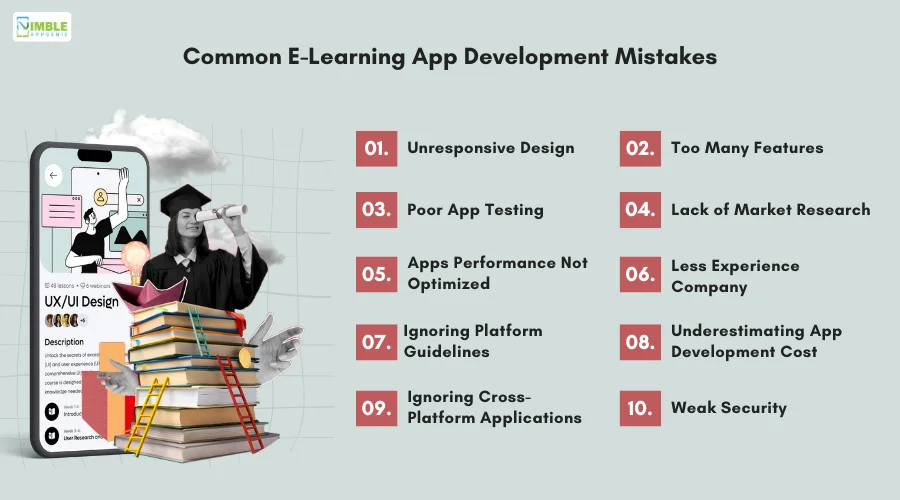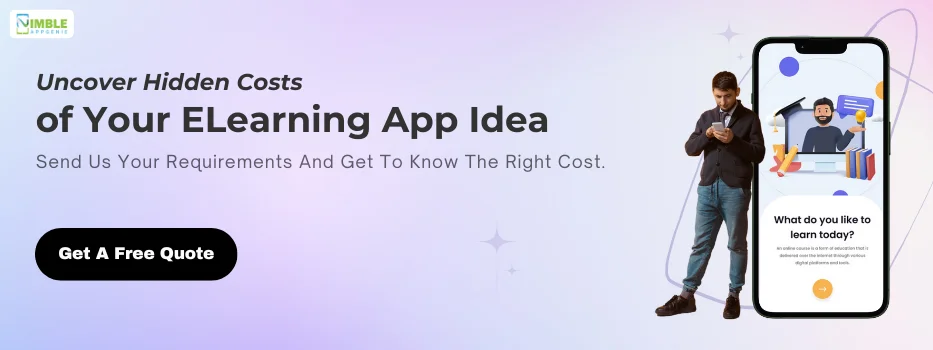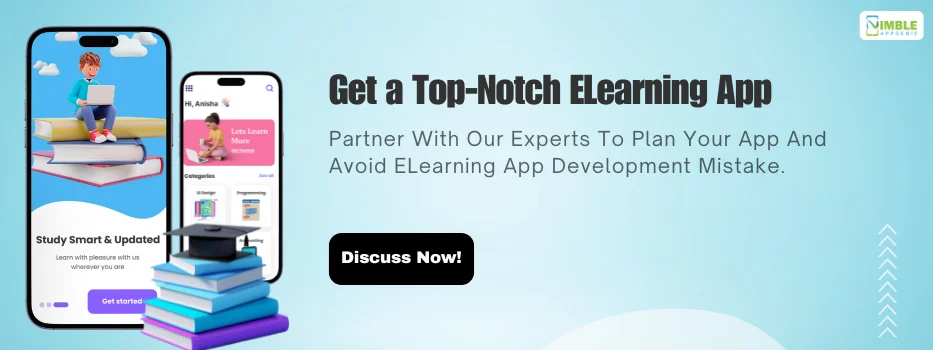Without any second thought, developing an educational app is a vibrant space where creativity meets ever-changing user needs. It’s a constant learning curve, but the rewards are huge!
Taking a closer look, we found that the market of Education apps is becoming bigger than ever and is projected to grow at a 28.61% CAGR by 2027. Seeing this, it’s a great sign that now could be a prime time to explore your educational app idea.
Beyond competition, every investor should know about the development mistakes of an education app to avoid in this dynamic space.
Also, by learning about these common mistakes, you can equip yourself with the skills to build an educational app that breaks through the noise and becomes a trusted source for students to connect with.
Now, with that, let’s get to know about those mistakes, but before that a quick look at the market:
What’s the Size of the Education App Market?
Building a successful educational app starts with understanding the market.
Let’s dive into the current market share and user needs to ensure your app stands out.

The E-learning market is booming!
In 2021, it was valued at a whopping $214.26 billion and is about to reach $1,124.79 billion in 2030 and experts predict it will continue to surge at a rate of 20.5% annually during the forecast period from 2021 to 2030.
AI and machine learning are revolutionizing e-learning by personalizing content for each student.
As a result, there are many homeschool apps, educational apps, and more that are offering users amazing features catering to different needs and preferences.
But, if you want to embark on this journey, you should know about Development Mistakes to avoid and overcome.
Common Development Mistakes of an Educational App
To be the best educational app, it is necessary to know about these common development mistakes in eLearning apps and their viable solutions.

So, your app doesn’t get lost in the sea of other education apps. Let’s get to know about them:
1. Unresponsive Design
Imagine developing an app that students are not able to use properly. The layout looks messy and the text is unreadable.
Learning thrives on the smooth flow of information and interaction. Otherwise, this can be incredibly hard for students to find what they are looking for, and this might frustrate them.
It is not wrong to say that responsive design ensures your app adapts seamlessly across different screen sizes and devices, delivering a smooth learning experience for everyone. Repeated instances can lead to disengagement and a negative association with learning on the app.
Solution
To get out of this problem, ensure that buttons and other interactive elements change appearance when tapped to indicate they’re registering the touch.
Also, you need to work on app layout and interactive methods that work well on different sizes and devices so that students can easily access educational material from any device. To achieve success, it is a must to work on the UI/UX design of the app.
2. Too Many Features
Often this is considered that if you add too many features to your app, it might make your app successful. But, the truth is just the opposite. An app with too many features can be overwhelming and confusing for users.
They may struggle to find anything and might give up on the app in frustration. Plus, too many features can slow down your app and drain your app performance, leading to poor engagement.
Solution
To make sure that your app provides an amazing user experience, you must excel at core education app features. This way, users will identify the essential functionalities that directly address the learning needs of your target audience.
As you know features are the foundation of any app, you should always focus on quality, instead of quantity, and in the future whenever you plan to add new features based on user feedback.
This is one of the Development Mistakes to avoid.
3. Poor App Testing
Poor app testing is a critical mistake to avoid when developing an educational app.
As you know a buggy app can cause disturbance in the learning process. Crashes, freezes and errors can cause students to lose progress, forget where they were, and become frustrated. This can make learning unreliable and discourage them from using the app altogether.
For example, buttons that are too small or don’t provide clear feedback when tapped can be difficult for students. As a result, it might result in poor user experience.
Solution
You shouldn’t wait until the end of the development cycle to start testing. Integrate unit, integration, and API testing throughout the development process.
This will help you catch bugs early on when they are easier and cheaper to fix. In addition to functional testing, it’s important to test the usability of your app. Make sure your app is easy to use and navigate, plus conduct user testing sessions to get feedback from real users.
4. Lack of Market Research
Without understanding the market, you might develop an app that nobody needs or wants. And, undoubtedly, it will fail in the market.
A lot of time, an investor decides on the basis of guesswork without knowing who their target audience, what will be the pricing of the app and much more.
This is why, they get lost in the sea of other education apps.
Solution
Market research is the key to unlocking the market success of your app. To create an app like Udemy, you should do proper research to identify the target audience, pain points, and learning preferences.
Plus, app research helps you understand the features and functionalities that learners will actually find valuable in the market.
Overall, market research is like having a roadmap for your app development. Besides, what it does the best is to reduce the risk of failure by making sure you are building something people want.
5. Not Optimizing Mobile Apps For Performance
The market for eLearning Apps is at an all-time high.
It is not wrong to say that the purpose of educational software is to ensure that students can learn from anywhere and from any device.
But, learners today have short attention spans, and if your education app takes forever to load content, make videos, or transitions lag, users will feel frustrated and disengaged. Things like this can hinder them from gaining knowledge and lead to app abandonment.
Solution
Not everyone has access to high-end smartphones. Optimizing your app for performance ensures that it runs smoothly even on devices that have limited memory.
Performance is one of the core aspects and not optimizing it is a development mistake of an educational app that you shouldn’t make.
Overall, make sure to review your app and optimize the performance to ensure that your learners can enjoy the app.
6. Picking a Company With Less Experience
Choosing the right mobile app development company is the need of the hour.
There are many companies that claim to be experienced and expert in the domain. But, you should choose a partner that has a proven track record of success in developing engaging eLearning apps.
The key to successful e-learning goes beyond just building the app. It requires expertise in educational methodologies as well.
Without this understanding, the app might not be able to function technically, but it won’t offer the benefit of the education app you’re aiming for.
Solution
Without any doubt, it’s a common development mistake to avoid. What you can do is you can talk to past clients of the companies you’re considering.
You should see what their experience was like, thoroughly check their portfolio, and put questions in front of them. The development company should be happy to answer your question about their experience process and team.
Also, you can talk with past clients and get to know about the company better.
7. Ignoring Platform Guidelines
Talking about the platform guidelines, without any doubt it’s a huge development challenge of an education app that needs prior attention.
If someone skips app store guidelines it can be a reason to get rejected from the store and delays. Each platform has specific rules for design; functionality and content that you will need to follow in order to successfully launch your app.
Otherwise, ignoring them can result in costly affairs that you don’t want.
Solution
In order to avoid such development mistakes, one should review the app store guidelines and Google Play Store Developer Policy.
Besides, your app should adhere to all platform-specific requirements before submission. As a result, this can save time and frustration in the long run. This can save you from a lot of struggle and ensure that your app is ready to download by the user.
8. Underestimating the Cost of Mobile App Development
Knowing the cost to develop an education app might be one of the top priorities of any investor.
You see, there are several aspects that can lead to increasing the overall load on your budget. Development is just one aspect of it; factors like designing, testing, and maintenance are there.
Without analyzing these aspects, it is hard to tell or reach a point, leading to financial surprises later.
Solution
Developing a detailed project plan outlining all functionalities and features is a must.
For this, you should consult with the development company to get a comprehensive cost estimate that considers all aspects of app creation, including ongoing maintenance is necessary.
This will help your education app idea to thrive in the market without breaking the bank.
Also, they can also provide insights about industry standards and hidden costs that you might not be aware of.
However, make sure to break down the tasks and functionalities to understand about the time & resources required for each stage of development.
9. Not Working On Cross-Platform Applications
One of the critical mistakes to avoid when developing an educational app is not working on cross-platform applications.
Limiting your app to one app be it Android or iOS, limits your reach, as a result, you exclude a significant portion of potential users. This could hinder your app’s adoption and impact its overall success.
Developing separate native apps for both iOS and Android requires building and maintaining two codebases. As a result, this can significantly increase development time and costs compared to a single cross-platform codebase.
Solution
Explore cross-platform development tools such as Flutter. This allows you to build a single codebase that can function on both iOS and Android, saving development time and resources.
Also, this is one of the best ways to reduce the maintenance and support services cost as a single codebase is easy to manage and run.
10. Weak Security
Security is currently a top concern for people.
On one hand, breaches are so common. Whereas on the other side, app security has become a top concern. Educational apps handle sensitive user information, including login credentials, student progress data, and potentially even payment information.
Weak security of such information makes them vulnerable to data breaches. These breaches can be devastating, causing identity theft, financial loss, and reputational damage for both the app & its users.
Solution
In order for your education app business model to succeed in the market; you should equip it with an education app with top security measures and end-to-end encryption to protect data at rest and in transit.
Make sure to enforce multi-factor authentication to make it harder for unauthorized users to access accounts. Also, conduct regular infiltration testing to identify and address security vulnerabilities before they can be exploited.
Plus, keep your app’s software updated with the latest security patches to fix known vulnerabilities.
Nimble AppGenie: A True Partner to Develop an Education App
In order to overcome development mistakes to avoid while developing an educational app, it is necessary to partner with the best educational app development company, i.e. Nimble AppGenie.
By carefully planning your project, we as a team prioritize factors like security, user experience, and scalability.
So, if you have an idea, hire mobile app developers from us and get started today!
Conclusion
The educational app market is booming, but to succeed, you need to avoid common development mistakes.
This guide outlines 10 key mistakes to avoid, along with solutions to ensure your app delivers a valuable learning experience and attracts users.
By prioritizing factors like responsiveness, core functionalities, thorough testing, market research, performance optimization, and robust security, you can create an educational app that stands out from the crowd.
FAQs
There isn’t a single biggest mistake, but underestimating the importance of user experience (UX) can be critical. Learners won’t engage with an app that’s difficult to use or navigate.
Cross-platform development tools like Flutter allow you to reach both iOS and Android users with a single codebase, saving time and resources. Native apps offer optimal performance but require separate codebases for each platform.
Implement strong security measures like data encryption, multi-factor authentication, regular penetration testing, and keeping software updated to protect user data and prevent breaches.
Look for a company with experience in educational apps, a strong understanding of UX principles, and a focus on building secure and scalable solutions. Carefully evaluate their development process, communication style, and ability to meet your specific needs. Alternatively, you could go for Nimble AppGenie, which has a track record of launching successful educational apps.

Niketan Sharma is the CTO of Nimble AppGenie, a prominent website and mobile app development company in the USA that is delivering excellence with a commitment to boosting business growth & maximizing customer satisfaction. He is a highly motivated individual who helps SMEs and startups grow in this dynamic market with the latest technology and innovation.
Table of Contents






No Comments
Comments are closed.